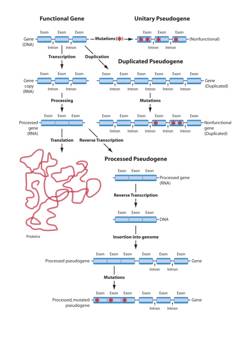Functional Pseudogenes Are Everywhere!
Like most children in the early 1970s, my Saturday morning routine centered round cartoon shows.
Klondike Kat was a particular favorite. As a wildcat serving in the Canadian Mounties, Klondike Kat squared-off against his nemesis, a French-Canadian mouse named Savoir-Faire. After committing a crime, the deviant rodent would announce in a French accent, “Savoir-Faire is everywhere!” Though outmatched, Klondike Kat always got his mouse.
Recently, scientists from China have discovered that, like Savoir-Faire, “functional pseudogenes … might be ubiquitous in eukaryotic organisms.”1
The very real possibility that large numbers of functional pseudogenes are universally distributed among eukaryotic organisms has a number of important biomedical implications. It also undermines the best argument for biological evolution.
Pseudogenes
Evolutionary biologists consider pseudogenes the dead, useless remains of once-functional genes. According to this view, severe mutations destroyed the capacity of the cell’s machinery to read and process the information contained in these genes. Still, pseudogenes possess tell-tale signatures that allow molecular biologists to recognize them as genes, albeit nonfunctional ones.
Molecular biologists distinguish several classes of pseudogenes. Duplicated pseudogenes are the largest class. Scientists posit that these DNA segments arose when gene(s) underwent duplication in the genome, after which the duplicated copies experienced severe mutations, rendering them unrecognizable as a functional gene by the cell’s machinery. Loss of duplicated gene function has little, if any, effect on an organism’s fitness since an intact copy of the functional gene still exists. (The diagram below provides an overview of how the different types of pseudogenes arise.)

Pseudogenes and the Case for Biological Evolution
Traditionally, evolutionary biologists view pseudogenes as “junk” DNA and consider them among the most compelling pieces of evidence for biological evolution. Identical (or near identical) segments of junk DNA often occur in a wide range of related organisms and reside in corresponding locations in these genomes. For evolutionists, this occurrence clearly indicates that these organisms shared a common ancestor. They believe these junk DNA segments arose prior to the time when the organisms diverged from their shared evolutionary predecessor.
Skeptics often ask, “Why would a Creator purposely introduce nonfunctional junk DNA at the exact same location in the genomes of different, but seemingly related, organisms?”As it turns out, molecular geneticists have learned that a number of pseudogenes, including duplicated and processed pseudogenes, actually possess function.2
Proponents of the evolutionary paradigm offer this rejoinder: Yes, some pseudogenes are functional, but the vast majority lacks function; the vast majority is junk. They maintain that a small number of pseudogenes acquire function through a process called neofunctionalization. According to this idea, evolutionary mechanisms occasionally generate functional pseudogenes after the genes initially arise through mutational events.
Recent work, however, indicates that functional pseudogenes are not a rarity but occur widely in genomes. Other research also indicates that pseudogenes regulate gene expression by operating as molecular “decoys.” From a design perspective, this explains the close structural similarity between pseudogenes and their corresponding “intact” gene. In other words, gene-pseudogene pairs make regulation of gene expression possible.
Molecular biologists from China recently discovered a large number of functional pseudogenes in Trypanosoma brucei, a parasitic protist that causes sleeping sickness in humans. This organism has around 9,000 genes in its genome and about 900 pseudogenes. It appears as if nearly all of the pseudogenes pair to an intact gene and regulate its expression.
This work affirms earlier studies indicating that functional pseudogenes are commonplace. It also indicates that the occurrence of functional pseudogenes is widespread among all eukaryotic organisms because, from an evolutionary standpoint, protists anchor the evolutionary tree that led to plants, fungi, and animals. Therefore, if functional pseudogenes are present in protists, they must be present in all eukaryotic organisms.
The widespread occurrence of functional pseudogenes and the likely universal distribution of functional pseudogene decoys among eukaryotic organisms undermine biological evolution. Pseudogenes can be viewed as the work of a Creator, as features intentionally introduced into genomes for a purpose. It also makes it difficult to believe that neofunctionalization can explain the emergence of pseudogene function. It is one thing to say that pseudogenes occasionally acquired function via undirected natural processes. But it is another thing entirely to say that this happened over and over again, until virtually every pseudogene in the genome possesses function.
Whenever Klondike Kat was foiled by Savoir-Faire, he would shout, “I am going to make mincemeat out of that mouse.” Likewise, the mounting evidence of pseudogene function makes mincemeat out of evolution’s best argument.
Endnotes
- Yan-Zi Wen et al., “Pseudogene-Derived Small Interference RNAs Regulate Gene Expression in African Trypanosoma brucei,” Proceedings of the National Academy of Sciences, USA 108 (2011): 8345–60.
- I would refer interested readers to Who Was Adam? and The Cell’s Design for a discussion of a number of discoveries that ascribe function to pseudogenes. We also offer articles on our website that describe the discovery of functional utility for pseudogenes: here, here, and here.






